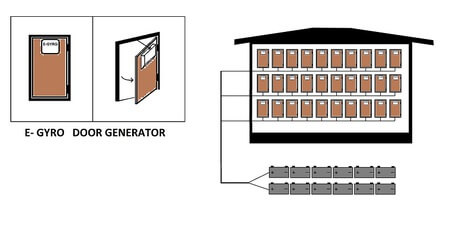Concept in Renewable Energy

The first thing you need to realize is that the energy you’re recovering is some portion of the work that went into opening the door, and that this is close to zero for most doors we encounter, simply because we don’t really want to do significant amounts of work in this context–and that’s even more the case for women and kids. In addition, we generally don’t want to be slowed down as we pass from one region of space to another, but let’s forget about what we want, and focus on the matter at hand.
Let’s say we made that hinge similar to that of a rowing machine, requiring a fairly intense pull to move the door. Work is the integral of force “dx” (over a distance). If the force is constant, it’s force times the distance across which the force is applied. Let’s simplify all this further and suggest that 200W, the power exerted by Olympic-trained athletes, be applied for 15 seconds, a total of 50 Watt-minutes, which we can round off to one Watt-hour.
Since the average U.S. home uses about 30 KWhs per day, we need to be prepared to ask the family who lives there to open that door 30,000 times daily. At 15 seconds per pull, you’d need five doors all being opened 24 hours per day.
Since that seems like a stretch for the modern, on-the-go family, I’m prepared to suggest that this idea, while not physically impossible, doesn’t have much practical applicability.

Craig,
This is an idea that just a little un-hinged ….., sorry, just couldn’t resist the opportunity to make an awful pun 🙂
But you are right, so many truly impractical ideas out there, so few practical applications.
I’ve often thought of collating and publishing some of the more bizarre proposals and inventions I’ve received over the years in a book of the weird and wonderful.
The only “human powered” ideas that make any sense at all would be piezoelectric walkways or floor tiles in extremely heavily trafficked areas. Something like Grand Central Station or the first floor entryway of the Smithsonian Museum of Natural History… Places where typically 10,000 or more people walk around on any given day.
Otherwise.. No.